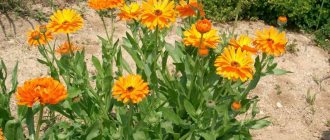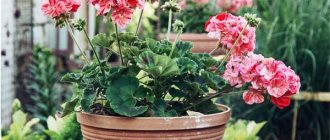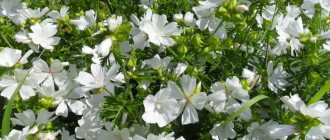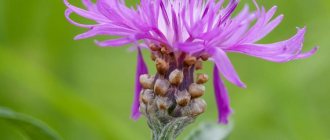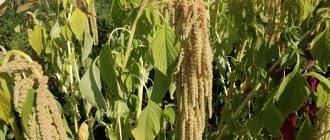This simple and familiar garden flower has incredibly powerful healing potential; many herbalists call its medicinal properties almost a panacea for all ills. Many people know calendula under the name “marigold”, and until recently it was difficult to find a summer cottage where these bright yellow-orange flowers would not be planted. Today, ceremonial flower beds are increasingly inhabited by tropical exotics and other stars of garden design, but in terms of its universal qualities, the humble calendula still remains unrivaled. It is a healer, a cosmetologist, an element of festive side dishes of haute cuisine, protection from harmful insects, and simply an elegant flower and a bright, cheerful accent in the landscape of a personal plot.
general description
Calendula is a branched flowering annual or perennial that can take a herbaceous or subshrub form. Belongs to the Astrov family. The stems are pubescent, straight, lodging in most species, with a ribbed cross-section. The arrangement of the leaves is alternate, their shape is oval-elongated or lanceolate. Long peduncles bear buds high above the curtain, forming at the ends single basket-type inflorescences, painted in a sunny range of colors - from pale yellow to deep orange with a brown-burgundy edging.
Flowering is very long, lasting almost the entire warm season. The buds open anew every day and close in the evening at sunset. Only in the most cloudy and rainy weather can they remain closed all day.
Calendula seeds have a curved shape, which led to the popular name of the flower “marigold”. Their germination persists for 4-5 years.
Beneficial properties of calendula
Marigold flowers are used as medicinal raw materials , which have strong bactericidal properties against many pathogens, especially staphylococci and streptococci.
Infusion of calendula or marigold
Calendula infusion is used as a wound-healing, bactericidal and anti-inflammatory agent. Calendula is used to make medicines that are used to treat damage to the skin: burns, non-healing wounds, gargling for sore throats and the mouth for stomatitis.
Varieties of calendula
Within the genus, about 20 plant species have been described. Based on them, many decorative garden forms have been developed, however, most often in gardens you can find calendula officinalis. For those who plant marigolds solely to obtain medicinal raw materials, you should know that the development of new varieties is carried out in two directions at once - medicinal and decorative. Moreover, Russian breeders are more focused on medicinal raw materials. Therefore, when choosing seeds for planting for the purpose of collecting and using medicinal material, you should not limit it to one well-known species.
Calendula field
A low annual variety up to 30 cm. Thick, straight stems are softly pubescent, highly branched. Along the entire length of the shoots, petiolate sessile leaves are arranged in a regular order. The flowers are solitary, small, pale mustard color. It is not in great demand among gardeners, but is often sold in flower seed stores.
Calendula officinalis
The flowers of this variety are grown commercially for the pharmaceutical industry and are the most famous and widespread type of plant. It is correct to consider them “marigolds”. It is also an annual plant, but can have more impressive dimensions than the previous species, up to 70 cm. The shoots are straight, highly branched, colored in the same light green tone with oval simple leaves. The leaf blades are finely and softly pubescent. The flowers are yellow-orange with a slight transition to brown, the upper surface of the petals is smooth, shiny, the lower surface is matte. The central part of the inflorescence is strewn with small tubular petals, painted in the same colors. Flowering begins relatively late, by mid-summer, but continues almost until the first snow. The plant produces numerous seeds with excellent germination, which lasts up to 5 years.
Based on calendula officinalis, numerous varieties of decorative and medicinal purposes have been bred.
Both have medicinal properties and applications, but the former have priority qualities such as external characteristics and duration of flowering.
Calendula "Radio"
Medium-sized terry and semi-double, depending on the variety, grows up to half a meter. Rigid shoots with a ribbed cross-section have increased rigidity, branch well, but almost do not bend. A characteristic feature of the species is the petals twisted into a tube, the diverging rays of which are similar to antennas and look original and impressive. The inflorescences are yellow-orange, slightly lighter in the middle, and quite large, especially in double varieties.
Variety "Bonbon"
The inflorescences of this variety have an external resemblance to marigolds, of a densely double type, with a rich yellow color. The stems are compact, up to 30 cm in height.
Variety "Indian Prince"
Very colorful flowers, painted in bright exotic colors. This is a tall variety, the stems of which reach 75 cm. The flowers are large, semi-double, with petals curved inward at the ends. In the center the petals are tubular, dark, with a transition to burgundy or bronze-brown. Grown by florists for cutting and making bouquets.
Calendula care
Calendula is grown in the garden as an annual plant, so there are practically no problems with it. There is no need to worry about wintering, and they are planted immediately in open ground.
Temperature and lighting
Calendula is a true sunny flower that loves light and warmth. Therefore, choose a well-lit area, and when germinating through seedlings, wait until the May frosts have passed before transplanting.
Photo: market.yandex.ru
Watering
Young shoots that are still gaining strength need to be carefully watered every other day. Adult plants are watered rarely, but abundantly, mainly on dry, hot days.
Photo: divo.site
The soil
Calendula requires moderately moist, but always loose and well-drained soil. The lack of nutritional value can be compensated for by fertilizers. You should not plant calendula in the same area for several years in a row.
Photo: 7dach.ru
Fertilizers and fertilizing
Ready-made mineral mixtures are perfect for marigolds. Apply them about once a month according to the instructions along with watering - and the flowerbed will delight you with its beauty.
Photo: pxhere.com
How to prolong the flowering of calendula?
There is one trick that will make calendula bloom all season long. As soon as all the petals of the basket completely open into a flat flower, it must be torn off immediately. And then the plant will have time to form new strong buds.
Photo: pulse.mail.ru
Statica (50 photos): types, care and planting in open ground
Growing Calendula
Caring for the plant is completely easy due to its unpretentious nature and natural adaptability to the climatic conditions of central Russia and its colder regions. For successful flowering you need to choose an open place. Calendula will easily tolerate temporary openwork shading, but will feel depressed in the absence of sun for a long time. In addition, the risk of powdery mildew will increase.
Watering
During the period of increasing the initial green mass, calendula requires a sufficient amount of water. Mature bushes can easily tolerate short dry periods, although if they occur during budding, the number of flowers can be significantly reduced.
To ensure flowering lasts longer, the flowers should be partially removed by periodically cutting them off.
This will allow the collection of medicinal raw materials for the benefit of the decorative appearance of the planting, the abundance and duration of its flowering.
Collection of raw materials
The best time to collect homemade calendula is when the plant reaches the peak of its flowering, i.e. most of the flowers will already be open. It is best to prepare them for further use in the morning in clear weather, after waiting for the dew to dry. The inflorescences are torn off, capturing a small part of the peduncle, and then dried in the shade in a well-ventilated place, for example, under a canopy outside in the absence of wind.
Collecting seeds
Even if the procurement and further use of seed material is not included in the plans of the site owners, it is better to collect the seeds to avoid self-seeding and uncontrolled growth of the planting. You need to start doing this as soon as they begin to crumble and the basket begins to darken. If the seeds are needed for further use, they will ripen perfectly in the cut basket while it is drying.
The plant is useful not only to humans, but also to the soil on which it grows and to other neighboring crops. Calendula grass and its underground part have the ability to disinfect the soil from pathogens and repel insect pests.
Calendula propagation
Calendula is propagated by seeds. Many varieties are characterized by vigorous self-seeding. If you do not collect calendula flowers in time, then it can fill the entire area next year. It is better to choose seeds, taking only the best specimens. They must be taken from the outer rows. You can collect seeds at the end of August or in September. They must be mature. To determine this, you need to look at the color of the flower; it turns dark brown.
Drying and storing seeds is of great importance. This can be done in different ways. A few hours after collection, it is advisable to place them in a dryer and heat them for about 4 hours at a temperature of 40°C. If there is no dryer, then you need to lay out the collected inflorescences in the sun and turn them over periodically. 2 days are enough for them to dry completely. They can then be put away in a drawer or cardboard box to create a dark environment. Thanks to these actions, the marigold will be suitable for planting and will not deteriorate over the winter.
There is no need to store seeds in plastic bags, because... this may lead to their damage.
Thus, growing calendula in open ground is not as difficult as it might seem. It grows unpretentiously and blooms vigorously. Bright flowers on the site will create a good mood. You can combine them in a flowerbed with other plants. Pairs well with marigolds, petunia and chamomile.
Diseases and pests
While repelling the vast majority of insects, calendula can only be affected by black and green aphids, the main carriers of which are ants. Therefore, it is necessary to fight not only and not so much with the pests themselves, but with their carriers; for this purpose, specialized stores have special preparations, including those for preventive purposes.
Of the diseases, the main troubles of calendula are gray rot and powdery mildew, which can easily be caused by too thick planting. If you notice dark or powdery spots on the leaves and shoots, you must immediately destroy the infected plants by burning them outside the garden area. Another provoking factor may be excessive or illiterate application of fertilizers.
Growing from seeds
There are two main options for growing seeds: sowing in open ground or preparing seedlings. The second method is used to obtain earlier flowering. It can be sown in open ground both in spring, after the soil has dried, and in autumn, after the onset of night frosts.
When growing calendula from seeds, you should know when to plant seedlings. The planting rules do not differ from those that are relevant for direct planting in the ground. You can determine the right time like this: take a lump of earth from the garden, squeeze it in your fist and let it free fall from a meter height. If after landing it crumbles, it’s time to plant marigolds. Typically, the optimal period begins in the third ten days of April, when the earth has dried out and warmed up sufficiently after winter.
12-15 days before planting, the soil is dug up with humus, using 3-4 kg of material per 1 m². It is also allowed to add 20 g of superphosphate and potassium chloride, 30 g of urea. Sowing into the ground occurs at a depth of 1-2 cm, interval: 25-30 cm. A distance of 60-70 cm should be maintained between rows . If calendula is needed for medicine, then the sowing interval is reduced to 7-10 cm, leaving 30-40 cm between rows.
The first shoots appear after 7-10 days. At this point, thinning is carried out. The released seedlings can be planted in another place - the flower easily tolerates a change in location. Flowering begins 70 days after sowing in the soil.
Wanting to reduce the time it takes for flowers to appear on marigolds, gardeners use seedlings. Planting in prepared containers is carried out from the end of February to the first days of April. After this, the containers are covered with glass, thereby preventing the soil from drying out. The cover is removed every day for ventilation. When the first shoots appear, the glass can be completely removed. The container is transferred to a well-lit place and moderate watering is provided.
When the time comes for planting in open soil, hardening is carried out. The containers must be placed outside for several days when the temperature is between 12-16 degrees. Although the plant is resistant to cold, thanks to hardening it will grow easier and will hurt less.
It’s not difficult to decide where calendula grows well. The area should be sufficiently lit, the soil moist and nutritious. Drainage is important, which will ensure the removal of excess moisture and prevent rotting of the roots. Marigolds protect other crops from pests, but substances released by the roots can slow down the growth of radishes and basil. This factor should be taken into account when disembarking.
Selecting seeds for planting
Before sowing seeds, they should be inspected. You should know that the most profusely flowering specimens can be obtained from thin, highly curved seeds. Wide and slightly curved seeds produce less fertile and strong plants.
Helpful neighborhood
Calendula can be grown not only in flower beds and in the garden, but also between beds with vegetables and other garden crops. Its smell serves as good protection against butterflies and other garden pests, including the Colorado potato beetle and spider mite. Plants near calendula are rarely affected by thrips and blackleg. However, it is not recommended to plant calendula too close to other crops, as this may slow down their growth and development due to the allopathic properties of this flower. Close proximity to basil and cruciferous vegetables (cabbage, radish, etc.) is especially undesirable.
Perennial types of calendula cannot be transplanted to a new location, since the plant forms a strong and extensive, but easily damaged root system.
Calendula – photo
You probably already know what calendula looks like. But her beauty is so often underestimated that we couldn’t deny ourselves the pleasure of collecting a large photo selection!
Photo: 1semena.ru
Photo: 7dach.ru
Photo: 7dach.ru
Photo: 7dach.ru
Photo: 7dach.ru
Photo: pizza-top.ru
Photo: pxhere.com
Photo: ortobotanicofrulano.com
Photo: foit.ru
Photo: water-vao.ru
Photo: zen.yandex.ru
Photo: fb.ru
Photo: oir.mobi
Photo: thespruce.com
Photo: cabinet.online
Photo: pixabay.com
Photo: 56440658067599.moi-6-sotok.rf
Photo: 7dach.ru
Photo: comfdesign.ru
Photo: dachneek.ru
Photo: dachnyedela.ru
Photo: plant-growing.com
Photo: stihi.ru
Photo: pulse.mail.ru
Photo: vikings-warofclans.ru
Did you like the post? Subscribe to our channel in Yandex.Zen, it really helps us in our development!
Chemical composition of calendula
The composition of the beneficial elements of the plant is very extensive; we will present only the main ones, the most important for medicinal use.
- Carotenoids. Help relieve inflammatory processes and have an antitumor effect, including malignant neoplasms.
- Sterols. Helps in the functioning of the heart and blood vessels, removing bad cholesterol.
- Triterpenoids. Stabilization of blood glucose levels, stimulation of the immune system.
- Flavonoids. Complex effects, including restoration of mucous membranes, removal of toxic substances, bile and radionuclides, relief of spasms.
- Calenden. Rapid scarring of skin lesions, prevention and treatment of dermatitis and eczema.
- Coumarins. Reducing the risk of thrombosis, increasing vascular elasticity.
- Lactone. Antitumor effect.
This is not a complete list of the beneficial properties of calendula and the beneficial elements it contains, vitamins, acids, etc.
Calendula in cooking
Marigold petals contain many plant pigments (as evidenced by their bright orange color). During the Middle Ages, this plant was used as a seasoning and added to porridges and first courses. Women were recommended to use jam from the petals to improve their mental state.
In those days, calendula was called “the spice for the poor,” because, unlike expensive overseas saffron, it was widely available. But the sharp, piquant taste of its leaves and flowers was also appreciated by court chefs. The English physician and naturalist John Gerard (1545-1612) wrote that not a single good cook in the Netherlands would cook soup without adding calendula petals. A cookbook from the time of Elizabeth I recommended adding the leaves of this plant to improve the taste of sparrow or lark.
This plant is still used in cooking today. Quite often, butter is colored with dried flower powder and added to some types of cheeses and meat broths. Marigold flowers can also be used to prepare various dishes.
Cucumber salad with calendula
Cut the cucumbers into slices, add coarsely chopped green onions and a few tablespoons of crushed calendula flowers. Season the salad with sour cream and sprinkle finely chopped dill on top.
Sandwich “Ryzhik”
Mix butter with crushed calendula petals and add sugar to taste. The resulting paste is spread on bread. This sandwich will surprise you with its taste and lift your spirits.
Viburnum drink with calendula
A glass of dried calendula flowers is poured with 2 liters of water and boiled for half an hour. Next, the broth is allowed to brew for 12 hours, after which it is filtered and a glass of honey and half a glass of viburnum juice are added.
Pickled marigolds
To prepare you will need 1 kg of calendula flowers, 150 ml of 9% vinegar, 40 g of salt, pepper to taste. Pour vinegar into the flower baskets, add salt and pepper and cook for 5 minutes. Place the flowers along with the marinade in clean jars and immediately roll them up. This preparation can be used to season second courses.
Dear readers! One article cannot fully reveal the full potential of such a useful plant as calendula. If you have your own experience-tested recipes for using calendula in cooking or traditional medicine, share them in the comments to the article. We will be very grateful to you!
Contraindications and side effects of using calendula
The main contraindication to taking any calendula-based products is pregnancy. The juice of the plant contains components that can promote miscarriage and provoke increased toxicosis, including uncontrollable vomiting. Calendula-based preparations and teas are not recommended for hypotensive patients due to their blood pressure-lowering effect. Age under 12 years is also a contraindication to the use of calendula preparations.
Prescription marigold-based medications are not recommended to be taken together with sedative medications.
Types and varieties of perennial garden calendula
In nature, there are from 12 to 20 species - representatives of the genus Calendula. To create decorative specimens, breeders use the technique of hybridization. The most common are two types - Medicinal and Field, which are pollinated by pollen of Bicolor (bicolor), Moroccan and other varieties.
Bracken fern - what it looks like and where it grows
The perennial large-flowered double calendula does not tolerate winters with temperatures below -10°C.
Important! To preserve flowers, in the fall they are transplanted into containers and transferred to a glazed balcony, greenhouse or windowsill.
Field calendula (Calendula arvensis)
It is widespread in the fields of southern Europe as a weed; it reproduces along roads and in forest clearings by natural seed dispersal.
Bushes 45-50 cm high, leaves are bright green and shiny. The flowers of the field variety are orange, simple, 1.5-2 cm in diameter.
Calendula officinalis (Calendula officinalis)
The most common type of marigold.
The flowers can be yellow, lemon-colored, or even whitish. The middle tubular flowers are darker than the reed flowers or the same color. The flowers are from 2 to 6 cm in diameter.
For medicinal purposes, flowers are collected at the moment of their full opening. The raw materials are dried under a canopy and stored in paper bags for no more than 1 year.
Other types
One of the popular varieties is Empress. It has double flowers with a diameter of up to 10 cm. The color of the petals is from dark yellow to light orange, the average height of the plants is 45 cm. The culture enlivens mixborders and is used as the main species in garden beds, containers and tubs.
The Geisha variety resembles a chrysanthemum. The orange petals have red tips. The center of the flower has purple and black spots.
A double variety with variegated petals is the Sonnenstein calendula.
Empress
Geisha
Sonnenstein
Planting calendula
Calendula is a cold-resistant, unpretentious crop that grows on any soil.
Of course, it is especially lush in fertile areas. It is better to choose a sunny place. In the shade, the flowers are not only paler, but their number is also smaller, and the plants themselves become longer. Sow calendula seeds directly into the ground in early spring: in April or May. It is possible even in winter - in October. Moreover, once you sow, you can forget about planting for a long time)). The plants lose their seeds and sprout on their own in the spring. However, do not forget to thin out. Both seedlings and already mature plants tolerate transplantation quite well - I simply transplant them to another place, and that’s all. Or I fill the empty space with them - so that it is not “thick and empty.” Yes, and one more thing: calendula seeds remain viable for 3-5 years! Sow to a depth of 2-4 cm. The distance between the seeds depends on what you want: lush free-standing plants or a whole clearing. Shoots appear within 10 days. You can thin out after 2-4 weeks. The distance between plants should be about 15 cm; They themselves are quite lush, with a lot of leaves)).
In about 50 days your marigolds will bloom. Usually this is mid-July. And they will bloom all summer and even in autumn. But less active: fewer flowers, more seeds).
By the way, some people sow calendula as seedlings and then plant them. To bloom earlier.
Description of the plant
Calendula officinalis (or marigold) is widespread and cultivated throughout the temperate climate zone. It is photophilous, cold-resistant and unpretentious to conditions. The plant is annual, erect, with different varieties the height varies from 20 to 70 cm. The medicinal raw materials are the inflorescences - baskets. They are yellow or orange. Along with the usual form of flowers, there is terry calendula. The plant blooms from June until autumn frosts. The fruits ripen in late summer - early autumn. Reproduces only by seeds.
Popular varieties
At first, calendula was grown as a medicinal plant. It has long been valued for its wound-healing and anti-inflammatory properties.
Since the 16th century, the plant began to be grown as a garden crop. As calendula grows, it turns into a spreading herbaceous bush with thick stems covered with coarse hairs. The leaves also have pubescence; they are elongated and oval in shape. The upper ones are thinner and smaller than the lower ones. Flowers with a diameter of 4–10 cm are arranged singly on the stem. Flowering time is June-November.
Breeders have developed many varieties for decorative and medicinal purposes. They differ in height, size, color and shape of flowers. The low-growing group includes plants with a height of 15–30 cm, the medium-growing group – 35–45 cm, and the tall ones reaching 50–80 cm.
Basket inflorescences can be simple or double, shaped like anemones, gerberas, and chrysanthemums.
The color of the inflorescences is all shades of cream, yellow and orange. You can grow varieties with variegated colors; in addition to the main color, markings in the form of white or brown strokes are visible on their petals.
Among low-growing plants, the Fiesta . These are compact bushes 25–30 cm high with double flowers 4–5 cm in diameter. The center of the dense inflorescences is dark, and the petals are orange, cream and yellow.
Calendula variety "Golden Heart" is beautiful in the flowerbed and cut. The bush is lush, 60 cm high. Double flowers look impressive. They have a green center and bright orange petals.
Calendula variety Radio
The petals of the inflorescences of the “Radio” look like small rays. They are half rolled into a tube, yellow-orange at the base, and bright orange at the ends. The bush grows up to 50 cm. It looks neat and compact.
Calendula variety Pink surprise
An interesting variety is “Pink Surprise” . Erect stems grow up to 50 cm. The flowers are double and large, 6–10 cm in diameter. In the inflorescences, the center is bright brown, and the petals are salmon-colored. In the sun they appear transparent. They smell nice and are good in bouquets.
Calendula variety Russian size
The variety “Russian size” . This is a spreading plant 50 cm high. The flowers are large, bright orange, 8 cm in diameter. It is characterized by abundant and long-lasting flowering. This calendula never stops blooming from July until frost.
Calendula is used for planting in ridges, groups, massifs, Moorish lawns, and the flowers are also well preserved when cut. The varieties Meteor, Orange Ball, and Radio are especially good.
Traditional recipes from calendula
Calendula oil
They also make oil from calendula at home. Flowers are poured into a glass container. Pour in unrefined olive oil. Place in a warm room for 8 days. Shake periodically to soak in oil. Strain through a fine sieve. Keep in the refrigerator on the bottom shelf.
How to brew a flower infusion correctly
Place 2 tablespoons of flowers in a saucepan with a liter of water and boil over low heat for 15 minutes. Then keep wrapped in a terry towel for one hour. After this, filter.
Tincture of marigolds with alcohol has found application in the treatment of acute respiratory viral infections and inflammatory processes. You can make this tincture at home: pour two tablespoons of dried flowers into 0.5 liters of boiling water and leave, wrapped in a towel, for 2 hours.
Strain, add boiled water and alcohol, half and half with water. If vodka is used, do not dilute it. The contents are covered and stored for 6–7 days in a cool, dark place. Strain and use for the prevention of infectious diseases.
How to prepare calendula ointment
Grind the flowers and mix with Vaseline, you can also add calendula oil.
Used for burns and skin damage. To achieve results, use daily until cured. This remedy is often used for cracked heels.
A decoction of calendula flowers is used in gynecology only after examination and advice from the attending physician. Important! Do not self-medicate, because calendula also has contraindications.


